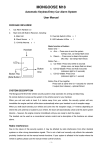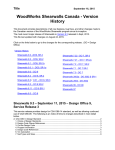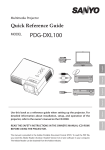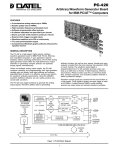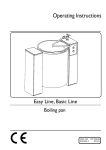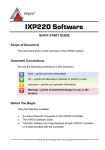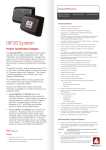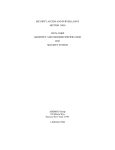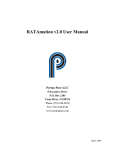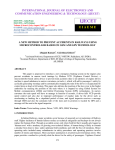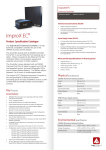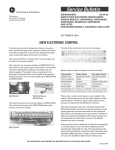Download View Manual
Transcript
CRYPTAG CENSUS SITE MANUAL IDENTEC READER TYPE ELCx Identec Ltd., Mercantile Road, Rainton Bridge Industrial Estate, Houghton-le-Spring, County Durham, England, DH4 5PH Tel: +44 (0)191 584 4084 Fax: +44 (0)191 584 9077 Web site: www.identec.com e-mail: [email protected] Issue 5 July 2003 This manual is provided for information purposes only. All information included in this manual is subject to change without notice. Identec is not responsible for any damages, direct or indirect, arising from or related to the use of this manual, or associated product. © Copyright 1999 Identec Limited. All rights reserved. Printed in the United Kingdom. This manual may be reproduced by Identec's customers for the purpose of assisting with the installation of Cryptag Census equipment. Reproduction in any form, physical or electronic, of all or part of this manual for any other purpose requires the express written permission of Identec Ltd. Trademark Notice: Cryptag is a registered trademark of Identec Ltd. Census is a registered trademark of Identec Ltd. Cliptag is a registered trademark of Identec Ltd. Identec is a registered trademark of Identec Ltd. Patents: Patents in the UK and other countries protect Cryptag systems. Registered Designs Various aspects of the reader design are registered. WARNING NOTICE This product uses radio frequency signals, and is therefore subject to possible interference. Any application should bear this in mind, and in particular it should not be possible for personal safety to be jeopardised by a failure to read. This reader neither uses nor generates hazardous voltages. You should not connect any such voltage to it. Identec Limited – Cryptag Census ELCx Site Manual Page 1 - 15 This product complies with the following European Community directives: 1 Low Voltage Directive. (73/23/EEC) EMC Directive. (89/336/EEC) This product confirms to the essential requirements of Articles 3(1)(b) and 3(2) Annex IV of Directive 1999/5/EEC. This product must only be used as described in the user manual. This product is intended for use in the following countries in accordance with the above directive: Belgium, Denmark, Finland, France, Germany, Holland, Iceland, Republic of Ireland, Italy, Luxembourg, Sweden and United Kingdom. FCC Regulations This device complies with Part 15 of the FCC Rules. Operation is subject to the following two conditions: (1) this device must not cause harmful interference, and (2) this device must accept any interference received, including interference that may cause undesired operation. FCC GRANT AUTHORISATION: JHD-CEN4 Note: Systems that comply with FCC regulations operate at different frequencies, and only such systems are to be installed in USA. These systems have some performance differences (in particular a slight increase in reading speed). Throughout this manual, the effect of the change in frequency is noted, e.g. “131kHz (in USA, 153kHz)”. The part numbers of readers and tags for use in USA have an “A” added, so the US version of ELCx is ELCxA. 1 For more information on approvals, refer to Appendix B. Identec Limited – Cryptag Census ELCx Site Manual Page 2 - 15 CONTENTS Chapter 1 Cryptag Census Label Reader Page Introduction The reader Unpacking Getting started 4 4 4 4 Chapter 2 Reader Location 5 Chapter 3 Installing and commissioning 6 Installation Commissioning 6 8 Chapter 4 Troubleshooting 9 Appendix A Technical Data 11 Appendix B Approvals 12 Appendix C User Instruction 13 1.1 1.2 1.3 1.4 3.1 3.2 Index 14 Identec Limited – Cryptag Census ELCx Site Manual Page 3 - 15 1. CRYPTAG CENSUS LABEL READER 1.1 Introduction Cryptag Census is a high performance tag identification system, offering fast long range multiple reading with the CR1 readers. Complementing the top end CR1 readers and short range EC1 range of readers, the ELCx (ELCxA-USA) reader provides a mid-range solution where moderate reading range is required. The ELCx is easy to install, and its thin profile means it can be mounted unobtrusively, for instance on doors. All Census Tags work on all Census Readers, but the reading range can vary. For most applications the instruction sheet provided with each reader should suffice. Installers should rarely (if ever) need to refer to this manual, which should be treated as a reference document. This manual complements the Identec website (www.identec.com), which contains more detailed technical information. The CR1Cryptag Census Site Manual also contains data on the Census tags. 1.2. The ELCx reader A Cryptag Census reader identifies tags (sometimes referred to as tokens or cards) using low frequency radio signals. ELCx transmits to the tag at 131kHz (in USA 153 kHz) and detects the tag’s response which is at 98kHz (in USA 115kHz). The USA version is denoted as ELCxA. The ELCx reader is configurable, and this is normally done in the factory. Configuration controls the output format, timings etc. 1.3 Unpacking Check that the package contains • Reader • Spacer • Labels • Manual and Installation Sheet • Mounting kit 1.4 Getting started 1. Connect a power supply to the reader. The positive connection goes to V+ (terminal 1), while the negative connection goes to 0V (terminal 2). The supply should be at least 6V, and should not exceed 18V. For optimum range the supply should be at least 12V. For supply voltages less than 12V reading range will be reduced. 2. Bring a tag near the reader. The reading range should be at least 100cm (39 inches) for a TC1 tag, but is usually more. (Reading range is reduced unless terminals 3 and 4 are connected.) 3. The red LED 2 (see page 8) will flash when the tag is within range. The red LED 2 will flash when the tag is being read. At the same time the red “Noise” LED 4 will flicker, and the flickering gets more intense as the tag gets closer to the reader. The green “Data” LED 3, will blink once when the tag’s identity is reported. 4. The reader reports the tag only once. The reader sends the identity of the tag when the tag is first identified. (As shown by the Data LED 3 with a single blink). To get another report, take the tag away from the reader for a few seconds, then bring it back in towards the reader. Identec Limited – Cryptag Census ELCx Site Manual Page 4 - 15 2. READER LOCATION The range of the ELCx is such that some care is needed in selecting the reader’s location. A Do not locate an ELCx reader near another reader. If tags can pick up signals from two or more readers, they respond to neither. The separation should be about 1.5 times the sum of their ranges. For the ELCx reader the reading range is normally well over 1 metre (3.3 ft), so two ELCx readers should be kept at least 3 metres (10 ft) apart. If there are readers from other manufacturers there may be an interaction. If the other reader uses frequencies similar to those used by Cryptag Census the safe distance may be more than expected. (This is because Cryptags are more sensitive than most tags.) B ELCx readers should not be mounted directly on to a metal surface. Not only will the reading range be severely affected, but also the current consumption will rise. (In extreme cases there is a danger that the reader may cut out temporarily.) It is safe to mount on metal using the spacer provided but reading range will be affected. The reader can be mounted on metal backboxes 75mm square (such as are used for standard electrical fittings). It is better to use plastic backboxes, as the metal backbox has a small effect on range. Take care not to over-tighten backbox attachment screw/bolts. C Interference. The reading range may be affected if the ELCx is mounted close to a computer monitor, or other sources of interference. (The effect on reading range will vary with the monitor’s scan frequency.) D ELCx readers can be mounted on glass or other flat surfaces using the spacer provided. The ELCx’s reading range is such that a Site Survey is desirable. Using the MS3 Test/Tune meter, the reading range will only be affected significantly if the MS3, with the probe attached, shows that the reading range is reduced below 1 metre. ELCx Label readers are designed so that they can be mounted directly on to a door. The reader’s dimensions match those of commonly used labels (signs), and the reader’s low profile and bevelled edges mean that it can be mounted unobtrusively. Using the spacer supplied, the reader can be mounted on other surfaces. In general the reader is best mounted in the centre of a door, or towards the handle. This maximises the probability of the tagholder being detected before reaching the door. The reader can be mounted on either side of the door. Check that no problems will arise from tags being read behind the reader or to the side. (The reading zone is almost spherical.) When tags are being carried by people, the best height should be selected with regard to the way in which tags will be read.. The best height is generally where tags will naturally be presented face on to the reader (except TC3). The reader should be within reach of people in wheelchairs. ELCx readers have LEDs fitted, but are covered by the label (sign). The ELCx requires a hole to be drilled in the surface on which it is to be mounted. This hole should be 45mm (1.75 inch) diameter, and have a depth of at least 10mm). If the reader is to be mounted on a fire door, make sure that the door’s integrity is maintained. If the reader is to be mounted in an outdoor location, you should use a suitable version of the reader. Identec Limited – Cryptag Census ELCx Site Manual Page 5 - 15 3. INSTALLATION AND COMMISSIONING 3.1 Installation Cabling Use screened cable, with the cable screen earthed at the other end from the reader (the controller end). Preferably the cable should not be more then 100 metres (330 ft) long for Wiegand interface, or 10 metres (33 ft) for the serial interface. Positioning the reader and labels A B Cable Access B B B Spacer Correctly Polarised ELCx SPACER MOUNT SPACER USING HOLES MARKED 'A' (Holes marked 'B' are for the reader fixings). A A Cable Access B B The ELCx reader is supplied with a spacer and a number of labels to suit different mounting locations. Use the spacer where it is not possible to drill a hole for the reader. Fixing to Glass: The labels are fitted last. Using double sided sticky tape, locate and fix the spacer in position with the cable running through one of the four Cable Access Points. After electrical connections have been made to the reader attach it to the spacer using the screws provided. After testing attach one label to the reader and for decorative purposes, another label on the other side of the glass. Identec Limited – Cryptag Census ELCx Site Manual Page 6 - 15 Lo Range Hi 0V V+ If the reader is to be mounted directly on to the door or wall, a hole 45mm diameter, and at least 10mm deep should be drilled at the centre of the desired reader position. An additional hole will also be needed to bring in the cabling to the reader. 1 6 10 RS232 D0(Clock) D1(Data) HOLD/CP Green LED 5 Connections The connections are shown above. The power supply to the reader (between 0V and V+) should be between 6V and 18V d.c.. The current consumption of the reader is approximately 60mA, so voltage drop in the cable should be considered but will rarely be a problem. The connections marked “Hi”, “Range” and “Lo” (terminals 3 to 5) allow the reading range to be adjusted. If Range is linked to Hi the reader will give full range, while connecting Range to Lo reduces the range to approximately 60%. Do not leave these unconnected, and do not connect them to anywhere else. (Leaving Range open circuit will give an intermediate reading range, but there is a danger that reading will be unreliable.) The green LED will light when the LED input is grounded (Pin 10). Identec Limited – Cryptag Census ELCx Site Manual Page 7 - 15 Readers can be configured as either Wiegand output or Clock/Data output. The same data connections are used, as shown in the drawing. The RS232 output is independent and it can be configured to give data after all tags. Card Present (CP) is available when the reader is configured for Clock/Data output, and goes low while data is being transmitted. (The Card Present terminal can also be reconfigured as a Wiegand Hold input terminal.) The ELCx has some protection against connection faults, but they do not cover all circumstances. 3.2 Commissioning Commissioning the ELCx is a simple process, consisting of first making sure the reader is working, and then checking that the data from the reader is reaching the controller. LED Location (Visible when front label removed) (LED 1) Green (LED 2) Red (LED 3) Data (LED 4) Noise To check that the reader is working, apply power to the reader. The red LED 2 should come on, as also should the Data LED 3. The Noise LED 4 should be off. Bring a tag in towards the reader. Three things should happen. The red LED 2 should start to flicker, showing that the tag is being read. The Noise LED 4 will flicker, and the flickering gets stronger as the tag gets closer to the reader. The Data LED 3 will flash when the tag is first read. This shows that tag data has been sent. To get the Data LED 3 to flash again, remove the tag, wait for a few seconds, and then bring it back in. Verify that the tag data is reaching the controller and that the green LED 1 (if used) is being driven by the controller. The reading range should be at least 100 cm (39 inches) for a TC1 if long range is selected (Range connected to Hi) and the typical range is 1.1m to 1.2m (up to 4ft). With the range reduced (Range connected to Lo) the reading range should drop to 60 to 70 cm (about 2 ft). If there are any problems, refer to the Troubleshooting guide in the next section. Identec Limited – Cryptag Census ELCx Site Manual Page 8 - 15 4. TROUBLESHOOTING It is rare for the reader to fail, so check the installation before proceeding. Refer to page 8 for LED locations. No LEDs come on This will normally mean that the reader is not receiving power of the correct polarity. Check the voltage on the reader terminals using a meter. If there is very bright light, it may not be possible to see the LEDs. If this is the case, the reader may need relocating. If the LEDs are still off, replace the reader. Red LED does not flicker when a tag is brought in, OR Data LED does not flash when a tag is brought in. This suggests that the tag is not being read. Make sure that the tag you are using is a working Cryptag Census tag. Is there another reader in the vicinity? See the section on reduced range. Red LED flashes, but no response by controller (i.e. no output message) Does the Data LED flash when the tag is brought in to the reader? If not check whether this tag is valid for the reader by reference to the HID (often used to define site code) of the tag? An ELCx may be configured to report some tags and ignore others. Is the tag being removed from the reading zone for sufficient time? Normally a few seconds will be sufficient, but it is possible for the ELCx to be programmed to wait for longer. (In this case you should have been informed.) Data LED flashes but there is no controller response Check the wiring to the controller. Has the controller been programmed to respond to the tag being used? NB If the power supply to the reader has had incorrect polarity, there is a small chance that the output circuit has been damaged. Tags are read, but range is low Check the Noise LED. This should be off when no tag is present. Any flickering on the Noise LED is likely to mean that reading range will be affected. Is there another reader nearby? Is there a computer monitor nearby? Is the reader mounted on metal? The ELCx is not designed to be mounted on metal. Using the spacer under theses circumstances can help increase the reading range. Is Range (terminal 4) connected to Hi (terminal 3)? Are there any other electrical systems that could cause interference. Try turning electrical equipment off to see if the reader is affected. Identec Limited – Cryptag Census ELCx Site Manual Page 9 - 15 Green LED does not come on Disconnect any wires to the LED terminal, and connect a wire from the 0V terminal to the LED terminal. The green LED should come on. If it does, check the wiring from the controller to the LED terminal. Does the signal to the LED terminal have the correct polarity? (0V to turn on.) Tag numbers reported incorrectly (Wiegand) The most likely cause is the Wiegand wires are reversed. Is the controller set up for the format used by the reader? If the system uses Site Codes, are these set up correctly? Tag numbers reported incorrectly (RS232) The reader is supplying data switching from -3V to +5Volts and as such is not true RS232. Tests have shown that this is compatible with most modern computer terminals. If the data appears to be garbage, check the baud rate etc. The normal for ELCx readers is 9600 baud, 8 data bits, one stop bit, no parity. Check that the RS232 line is not too long, and that connections are properly made. This will often give occasional errors. Repair The reader is designed to be "Installer-Friendly", and is rarely damaged, so please check the installation thoroughly. In the unlikely event that you find that the reader is faulty, you should replace the entire reader. Identec encourages its customers to return faulty equipment, as investigation of faults may help us improve the product. 12 month "no-quibble" guarantee All Identec readers and tags are guaranteed for 12 months against defective parts or workmanship from the date of despatch from the factory. Identec Limited – Cryptag Census ELCx Site Manual Page 10 - 15 Appendix A TECHNICAL DATA For more information on Cryptag Census in general, refer to the CR1 Site Manual. The reading range of ELCx is specified at 100cm minimum with a TC1 tag, but in general better ranges will be achieved. (Typical ranges are 1.1 metres to 1.2 metres.) This range assumes that the tag is in the optimum orientation and the readers supply voltage is greater than 12V. Reader mechanical details Dimensions 213mm x 163mm x 4.7mm 8.4 x 6.4 x 0.2 inches Weight approx. 200g (7 ounces) Colour/Material Grey ABS case. LEDs Red (internal control) Green (external control) Noise indication (red) Data sent (green). Electrical connections Screened cables are required to meet EMC requirements, as approvals were obtained with screened cables. Power input. 6-18V d.c. 60mA typical. (current depends on LED status.) 100mA max. The ELCx power connection is reverse voltage protected. There is a slight danger that incorrect connections on other terminals can damage the reader. Wiegand output Data on D0 and D1. Low going pulses 100µs long. (All timings are potentially configurable.) 1.6ms pulse separation Minimum 250ms between transmissions. Internal 1k pull-ups. Clock/Data output This uses the same circuitry as the Wiegand output. Serial data/RS232 (NOT TRUE RS232) Operates -3Volts Pulsing to +5Volts Transmit data only. No receive function. 9600 baud, 8 data bits, no parity, one stop bit. The reader reports a power up message, identifying itself. Each tag is reported in ASCII code, e.g. HID=00014 PID=01234 The numbers are reported in decimal. Configuration ELCx readers are normally configured by Identec. For advice on equipment to configure ELCx readers, contact Identec. Operating Environment -20°C to +60°C non-condensing. (Standard readers) Protected readers are available. Identec Limited – Cryptag Census ELCx Site Manual Page 11 - 15 Appendix B APPROVALS ELCx generally requires some form of approval, as it is an intentional emitter of radio frequency. This section describes the status of the product in various countries at the time of writing. For more up to date information contact Identec. This product confirms to the essential requirements of Articles 3(1)(b) and 3(2) Annex IV of Directive 1999/5/EEC. This product must only be used as described in the user manual. This product is intended for use in the following countries in accordance with the above directive: Belgium, Denmark, Finland, France, Germany, Holland, Iceland, Republic of Ireland, Italy, Luxembourg, Sweden and United Kingdom. United Kingdom ELCx is approved to MPT1337 and ETS 300 683 Other countries inside European Union ELCx is tested to ETS 300 330, for Radio Frequency emissions. The testing to ETS 300 330 and ETS 300 683 should be acceptable in all European Union countries. However certain national limitations may apply. United States of America FCC GRANT AUTHORISATION: JHD-CEN4 For the purpose of FCC, this range of product is classified as a low frequency intentional radiator. "The user is cautioned that any changes or modifications not expressly approved by the party responsible for compliance could void the user's authority to operate the equipment." --------------------------------------------------In all countries, this product is approved on the basis that it shouldn't cause interference to others, and that it won't be affected by interference. If you make an unauthorised modification, you may invalidate that approval, and you might be committing an criminal offence (depending on local legislation). Low Voltage Directive Cryptag Census readers have been designed and manufactured in accordance with EN60950, following the provisions of the Low Voltage Directive. ISO 9002 Identec's Quality System conforms to ISO 9002. (Certificate Number - FM36029) Identec Limited – Cryptag Census ELCx Site Manual Page 12 - 15 Appendix C USER INSTRUCTIONS C.1 After installing Cryptag Census, it is a good idea to make sure that the customer understands how the system works, and how to get the best out of it. What they are told depends on the type of application. This section provides information that will be useful to the manager responsible for the system, as well as the basis for information to give to all tagholders (if applicable). If personnel are carrying tags, show them how to present a tag to a reader face on. Explain that tags are much less likely to be read if they are on their side (for instance lying in the bottom of a bag). Tags do not read as well inside bags with metal frames, or surrounded by keys and coins. The identity of the tag will not be incorrectly reported, but the range may be affected. Once a tag has been reported, most software versions will not report that tag again until it has been taken right out of the reading zone for several seconds, then brought back. If you need the door to unlock again, you must walk well away from the reader before returning to it. Tags must not be left within range of readers. The battery inside the tag will be used up. If the tag is left next to a reader for several weeks the battery would become totally flat. C.2 Tag disposal When a tag reaches the end of its life, it should be disposed of properly. As there may be considerable time before this happens, and environmental policy may have changed in the meantime, we recommend: Tags contain a small lithium battery, and should be disposed of accordingly. If you are uncertain about how to dispose of tags, they may be returned to Identec for disposal. C.3 End User Instructions This section can be used to generate simple instructions for end users. You have been provided with a Cryptag Census tag. Application information to be given here. To get the best out of your tag, would you please spare a few moments to read this. The tag operates best when it is in the same plane as the readers, which are usually mounted vertically. You will get good performance if the tag is worn vertically, but not so good if the tag is placed flat in the bottom of a bag. The performance of the tag will be affected if it is surrounded by metal objects such as coins, keys or mobile phones. (The larger the metal object, the more effect it can have.) This tag has been designed and built to work under conditions met in normal daily use, but for reliable operation the following precautions should be observed:1. 2. 3. 4. Do not bend the tag excessively. It should not be kept in the back pocket of trousers, or other places where it may be subject to bending. Do not immerse in water, or allow it to come in contact with solvents. Do not leave the tag in a hot place (e.g. on a radiator). This tag contains a small battery, which under normal circumstances will last 5 years for some Tag modules. Battery life will be reduced if the tag is left for long periods within range of a Cryptag Census reader. Identec Limited – Cryptag Census ELCx Site Manual Page 13 - 15 INDEX I A approvals, ASCII, 12 11 installation, interference, introduction, ISO 9002, 6 5,19 4 12 kit mounting, 4 Label, LEDs, Lithium, location, low range, low voltage directive, 6 4-5, 8-9, 11 13 5 9 2, 12 mechanical data, metal, monitor, mounting, mounting kit, MPT 1337, MS3 test/tune, 11 5 9 5-6 4 12 5 Noise LED, 4-5, 8-9, 11 operating environment, outdoors, 11 5 patents, PID, power, programming option, 1 11 4,11 11 reader, reading range, red LED, RS232, returns 4 5,11 4-5, 8-9, 11 10-11 10 J B backbox, battery, baud rate, 5 13 10-11 case, clock/data, commissioning, computer, configuration, connections, contents, 11 11 8 9 11 7,11 4 C K L M D data LED, decimal dimensions, disposal of tags, drilling hole, 4, 8, 10-11 11 11 13 5 EMC directive, EN 60950, environment, ETS 300 683, ETS 300 330, 2,12 12 11 12 12 E N O F fault-finding, FCC, 9 2, 12 P G getting started, green LED, guarantee, 4 4, 7-9, 11 10 height, HID, 5 11 H Q R Identec Limited – Cryptag Census ELCx Site Manual Page 14 - 15 S safety, separation of readers, serial data, site codes, site survey, spacer, starting, supply voltage, 1 5 10-11 9-10 5 5-6 4 4, 11 tag disposal, tag numbers, tags, technical data, temperature, trademarks, troubleshooting 13 10-11 4, 13 11 11 1 9 unpacking, user instructions, 4 13 Voltage, 4,11 warning, weight, wheelchairs, Wiegand, 1 11 5 10-11 T U V W X Y Z Identec Limited – Cryptag Census ELCx Site Manual Page 15 - 15


















